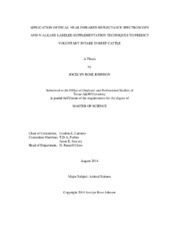| dc.description.abstract | The objectives of this study were to evaluate the use of fecal NIRS profiling and the n-alkane labeled supplementation method for the prediction of voluntary intake in beef cattle for the identification of animals divergent in feed efficiency. Additionally, the use of fecal NIRS profiling technology was evaluated for the prediction of diet characteristics.
To examine the use of fecal NIRS profiling to estimate diet quality and dry matter intake (DMI), fecal samples and phenotype data were collected from 14 beef cattle trials that utilized Calan-gate feeders (American Calan, Northwood, NH) or electronic GrowSafe™ feedbunks (GrowSafe™ DAQ 4000E; GrowSafe™ system Ltd., Airdire, AB, Canada) to measure individual animal feed intake.
The coefficient of determination for calibration (R_(c)^(2)) and cross-validation (R_(cv)^(2)) of combined trial equations to predict diet characteristics were least accurate for the prediction of NDF using composite fecal samples (R_(c)^(2) = 0.85; R_(cv)^(2) = 0.82), and most accurate for the prediction of CP using individual-day fecal samples (R_(c)^(2) = 0.94; R_(cv)^(2) = 0.91). For the prediction of DMI, R_(c)^(2) and R_(cv)^(2) ranged from 0.49 and 0.42 for the prediction of average-trial DMI using individual-day fecal samples to 0.76 and 0.73 for the prediction of fecal-collection-period DMI using composite fecal samples. While the values obtained for the prediction of DMI were inferior to those obtained for the prediction of diet quality or digestibility, fecal NIRS prediction equations for DMI were successful in predicting the mean DMI of groups as well as predicting individual-animal DMI for the evaluation of divergent RFI groups.
To evaluate the use of an n-alkane labeled supplement for the prediction of intake, 24 mid-gestation heifers, previously identified as having divergent postweaning RFI, were fed chopped sorghum hay and an n-alkane labeled supplement, ad libitum in electronic GrowSafe™ feedbunks (GrowSafe™ DAQ 4000E; GrowSafe™ system Ltd., Airdire, AB, Canada). In this study, accurate intake predictions were not obtained as 6-d forage intake was overestimated by 73.0% when using C_(31):C_(32) alkane pairs and by 38.9% when using C_(33):C_(32) alkane pairs. However, inaccurate measures of supplement and forage intake by the GrowSafe™ system, as well as large between-animal variation in supplement intake, feeding behavior, and digestibility may have greatly influenced the accuracy of these results.
Results from this study indicate that fecal NIRS profiling can be used to predict dietary characteristics and DMI for the identification of animals divergent in feed efficiency. Conversely, the n-alkane labeled supplement technique was inaccurate in predicting forage intakes in this trial. | en |


